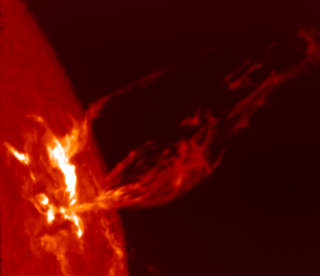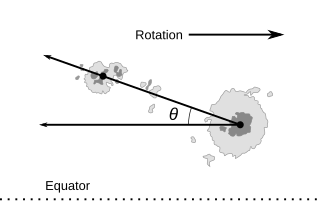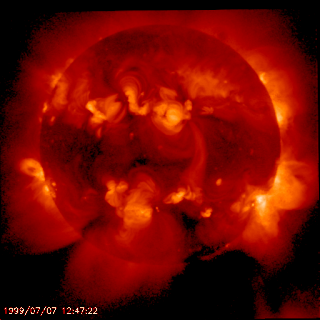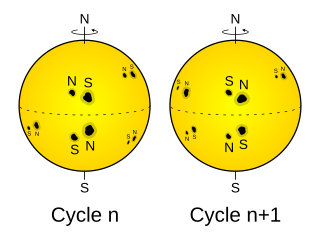In solar physics, the Babcock model and its variants describe a mechanism with which they attempt to explain magnetic and sunspot patterns observed on the Sun. It is named after Horace W. Babcock.
In solar physics, the Babcock model and its variants describe a mechanism with which they attempt to explain magnetic and sunspot patterns observed on the Sun. It is named after Horace W. Babcock.
The modern understanding of sunspots starts with George Ellery Hale, who linked magnetic fields and sunspots. Hale suggested that the sunspot cycle period is 22 years, covering two polar reversals of the solar magnetic dipole field.
Horace W. Babcock proposed in 1961 a qualitative model for solar dynamics. [1] On the largest scale, the Sun supports an oscillatory magnetic field, with a quasi-steady periodicity of 22 years. [2] [3] This oscillation is known as the Babcock-Leighton dynamo cycle, proposed by Robert B. Leighton, amounting to the oscillatory exchange of energy between poloidal and toroidal solar magnetic field ingredients.
A half-dynamo-cycle corresponds to a single sunspot solar cycle. At a solar maximum, the external poloidal dipolar magnetic field is near its dynamo-cycle minimum strength, but an internal toroidal quadrupolar field, generated through differential rotation, [4] is near its maximum strength. At this point in the dynamo cycle, buoyant upwelling within the convective zone forces the emergence of a toroidal magnetic field through the photosphere, giving rise to patches of concentrated magnetic field corresponding to sunspots.
During the solar cycle’s declining phase, energy shifts from the internal toroidal magnetic field to the external poloidal field, and sunspots diminish in number. At a solar-cycle minimum, the toroidal field is, correspondingly, at minimum strength, sunspots are few in number, and the poloidal field is at its maximum strength. With the rise of the next 11-year sunspot cycle, magnetic energy shifts back from the poloidal to the toroidal field, but with a polarity that is opposite to the previous cycle. The process carries on continuously, and in an idealized, simplified scenario, each 11-year sunspot cycle corresponds to a change in the overall polarity of the Sun's large-scale magnetic field. [5] [6]

Sunspots are phenomena on the Sun's photosphere that appear as temporary spots that are darker than the surrounding areas. They are regions of reduced surface temperature caused by concentrations of magnetic flux that inhibit convection. Sunspots appear within active regions, usually in pairs of opposite magnetic polarity. Their number varies according to the approximately 11-year solar cycle.

A solar flare is a relatively intense, localized emission of electromagnetic radiation in the Sun's atmosphere. Flares occur in active regions and are often, but not always, accompanied by coronal mass ejections, solar particle events, and other eruptive solar phenomena. The occurrence of solar flares varies with the 11-year solar cycle.
Starspots are stellar phenomena, so-named by analogy with sunspots. Spots as small as sunspots have not been detected on other stars, as they would cause undetectably small fluctuations in brightness. The commonly observed starspots are in general much larger than those on the Sun: up to about 30% of the stellar surface may be covered, corresponding to starspots 100 times larger than those on the Sun.

The solar cycle, also known as the solar magnetic activity cycle, sunspot cycle, or Schwabe cycle, is a nearly periodic 11-year change in the Sun's activity measured in terms of variations in the number of observed sunspots on the Sun's surface. Over the period of a solar cycle, levels of solar radiation and ejection of solar material, the number and size of sunspots, solar flares, and coronal loops all exhibit a synchronized fluctuation from a period of minimum activity to a period of a maximum activity back to a period of minimum activity.

The Gnevyshev–Ohl rule is an empirical rule according to which the sum of Wolf's sunspot numbers over an odd cycle exceeds that of the preceding even cycle—see the Figure. The rule breaks down under certain conditions. In particular, it invertes the sign across the Dalton minimum, but can be restored with the "lost cycle" in the end of the 18th century. The nature of the GO rule is still unclear.

18 Scorpii is a solitary star located at a distance of some 46.1 light-years from the Sun at the northern edge of the Scorpius constellation. It has an apparent visual magnitude of 5.5, which is bright enough to be seen with the naked eye outside of urban areas. The star is drifting further away with a radial velocity of +11.6.

The heliospheric current sheet, or interplanetary current sheet, is a surface separating regions of the heliosphere where the interplanetary magnetic field points toward and away from the Sun. A small electrical current with a current density of about 10−10 A/m2 flows within this surface, forming a current sheet confined to this surface. The shape of the current sheet results from the influence of the Sun's rotating magnetic field on the plasma in the interplanetary medium. The thickness of the current sheet is about 10,000 km (6,200 mi) near the orbit of the Earth.
The solar dynamo is a physical process hypothesized to generate the Sun's magnetic field, as explained with a variant of the dynamo theory. A naturally occurring interior electric generator presumably produces electric currents and a magnetic field, following the Ampère, Faraday, Ohm, and fluid dynamics laws, which compose the laws of magnetohydrodynamics.

In solar physics, a coronal loop is a well-defined arch-like structure in the Sun's atmosphere made up of relatively dense plasma confined and isolated from the surrounding medium by magnetic flux tubes. Coronal loops begin and end at two footpoints on the photosphere and project into the transition region and lower corona. They typically form and dissipate over periods of seconds to days and may span anywhere from 1 to 1,000 megametres in length.

A stellar magnetic field is a magnetic field generated by the motion of conductive plasma inside a star. This motion is created through convection, which is a form of energy transport involving the physical movement of material. A localized magnetic field exerts a force on the plasma, effectively increasing the pressure without a comparable gain in density. As a result, the magnetized region rises relative to the remainder of the plasma, until it reaches the star's photosphere. This creates starspots on the surface, and the related phenomenon of coronal loops.

Helmet streamers, also known as coronal streamers, are elongated cusp-like structures in the Sun's corona which are often visible in white-light coronagraphs and during solar eclipses. They are closed magnetic loops which lie above divisions between regions of opposite magnetic polarity on the Sun's surface. The solar wind elongates these loops to pointed tips which can extend a solar radius or more into the corona.
An active region is a temporary region in the Sun's atmosphere characterized by a strong and complex magnetic field. They are often associated with sunspots and are commonly the source of violent eruptions such as coronal mass ejections and solar flares. The number and location of active regions on the solar disk at any given time is dependent on the solar cycle.

In astronomy, Joy's law describes the distribution of sunspots in active regions and states that the magnitude at which the sunspots are "tilted"—with the leading spot(s) closer to the heliographic equator than the trailing spot(s)―grows with the latitude of these regions. Joy's law provides observational support for the operation of the "alpha effect" in solar dynamo action. It is named after Alfred Harrison Joy.

Solar cycle 25 is the current solar cycle, the 25th since 1755, when extensive recording of solar sunspot activity began. It began in December 2019 with a minimum smoothed sunspot number of 1.8. It is expected to continue until about 2030.
Solar observation is the scientific endeavor of studying the Sun and its behavior and relation to the Earth and the remainder of the Solar System. Deliberate solar observation began thousands of years ago. That initial era of direct observation gave way to telescopes in the 1600s followed by satellites in the twentieth century.

Solar phenomena are natural phenomena which occur within the atmosphere of the Sun. They take many forms, including solar wind, radio wave flux, solar flares, coronal mass ejections, coronal heating and sunspots.

In solar physics, a transequatorial loop is a structure present in the solar corona that connects two different regions of opposite magnetic polarity in opposite hemispheres of the Sun. These connected regions are not limited to active regions, but are most commonly found during the times of maximum solar activity, the solar maximum.
Erich Otto Ernst Rieger is a German astrophysicist who spent his research career at the Max Planck Institute for Extraterrestrial Physics (MPE) near Munich. He is notable for his 1984 discovery of the period of ~154 days in solar flares. Since the discovery, the period has been confirmed in most heliophysics data in the Solar System, including the interplanetary magnetic field, and has become known as the Rieger period (PR).

In solar physics, Hale's law, also known as Hale's polarity law or the Hale–Nicholson law, is an empirical law for the orientation of magnetic fields in solar active regions. It applies to simple active regions that have bipolar magnetic field configurations where one magnetic polarity is leading with respect to the direction of solar rotation. Hale's law states that, in the same northern or southern solar hemisphere, such active regions have the same leading magnetic polarity; that, in opposite hemispheres, such active regions have the opposite leading polarity; and that, from one sunspot cycle to the next, these polarities reverse. It is named after George Ellery Hale and Seth Barnes Nicholson whose observations of active-region magnetic fields led to the law's formulation.

HD 125248 is a binary star system in the equatorial constellation of Virgo. It has the variable star designation CS Virginis, while HD 125248 is the designation from the Henry Draper Catalogue. This system is dimly visible to the naked eye as a point of light with an apparent visual magnitude that ranges from 5.84 down to 5.95. It is located at a distance of approximately 280 light years from the Sun based on parallax measurements, but is drifting closer with a heliocentric radial velocity of −8 km/s.